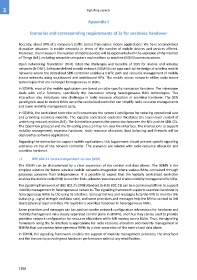Page 1368 - 5G Basics - Core Network Aspects
P. 1368
3 Signalling aspects
Appendix I
Scenarios and corresponding requirements of Ss for seamless handover
Recently, about 90% of a company's traffic comes from native mobile applications. We have accomplished
disruptive advances in mobile networks in terms of the number of mobile devices and services offered.
Moreover, the increase in the number of mobile devices will be exponential with the explosion of the Internet
of Things (IoT), including wearable computers and machine to machine (M2M) communications.
Open networking foundation (ONF) listed the challenges and benefits of SDN for mobile and wireless
networks [b-ONF]. Software-defined mobile network (SDMN) is an approach to the design of wireless mobile
networks where the centralized SDN controller enables a traffic path and resource management of mobile
access networks using southbound and northbound APIs. The mobile access networks utilize radio access
technologies that are no longer homogeneous or static.
In SDMNs, most of the mobile applications are based on radio-specific interaction functions. The interaction
deals with L1/L2 functions, specifically the interaction among heterogeneous RAN technologies. This
interaction also introduces new challenges in radio resource allocation or seamless handover. The SDN
paradigm is used to control RANs since the centralized controller can simplify radio resource managements
and lower mobility management costs.
In SDMNs, the centralized controller will concentrate the network intelligence for reducing operational cost
and providing seamless mobility. The logically centralized controller facilitates the lower-level control of
underlying network entities (NE). The Ss interface permits the interaction between the NEs and the SDN CEs.
The OpenFlow protocol and the OF-config protocol may run over this interface. The interactions to support
mobility management, seamless handover, radio resource allocation, load balancing and firewalls will be
deployed as software applications.
Regarding the interaction to support mobile applications, this Supplement should present specific signalling
scenarios on top of the network controller. The scenarios are related with radio resource allocation and
seamless handover.
I.1 IEEE 802.21 media independent service (MIS)
The SDMN can be characterized by a clear separation of the control and data planes. The SDMN is the
simplest solution for future wireless mobile networks integration where various RANs connected through
gateways conserve their independence. It is possible to expect that the logically centralized controller
enables the mobile node (MN) to monitor links, allocate resources and enable mobility management for MNs.
The signalling framework of IEEE 802.21-2008 standard [b-IEEE 802.21] can be a common platform to support
mobility management in heterogeneous networks. The signalling framework supports seamless handover in
heterogeneous RANs by the using Ss interface. Some primitives and messages help the MN to monitor link
status (e.g., signal strength and data rate), and some primitives and messages help the MN to control its link
layers (physical layer and data link layer) for a seamless handover in heterogeneous RANs.
Some primitives and messages can be used to transfer network configuration information for handover and
mobility management via a clearly separated control plane in SDMNs, and thus they can be used to provide
seamless network configuration for resource allocations while MN moving across RANs. Thus, the signalling
framework using the Ss interface is appropriate for radio resource allocation and mobility management in
SDMNs that use various heterogeneous RANs by a clear separation of the control and data plane.
In SDMN, the signalling framework enables the support of mobility management protocols, the interfaces
and the services to provide good handover performance without any modification.
1358

